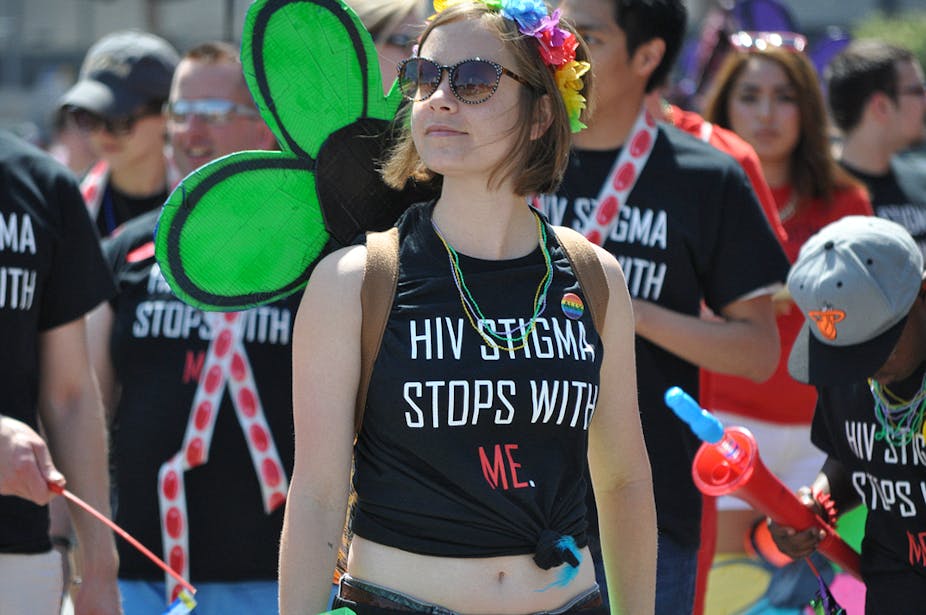Sexual ethics is an area prone to strongly felt moral intuitions. We saw this play out in the good, bad and sometimes ugly commentary following Charlie Sheen’s public disclosure of his HIV status.
But just how much disclosure is it reasonable to expect from a sex partner, particularly if that relationship isn’t a serious and committed one?
Common morality
There is a “common morality” precept that for sex to be truly consensual, sexual partners need to disclose certain facts to their intended partner. This includes information about sexually transmissible infections, and whether the person is in a committed (supposedly) exclusive relationship such as a marriage.
Identity is also relevant. It’s generally considered wrong (and often a crime) to have sexual relations with someone by means of deception such as impersonation.
Withholding material facts or deceiving a sexual partner deprives a partner of making an informed choice about whether or not to engage in sex, given the particular social and health contexts that apply. If consent to sex was dependent on an intentional deception, it was coerced rather than freely given.
This “common morality” precept is also upheld from a sexual rights perspective. This decrees that every person has the right to freedom and to protection from harm, such as those harms that accrue from coerced sex.
But there are exceptions
These principles appear fairly straightforward but can become vexed when there is risk for the person disclosing, or it’s unclear whether the facts themselves require disclosure.
Consider instances where transgendered people may seek to “pass” as their non-birth gender to a sexual partner.
Under the sexual rights framework, all people have a right to non-discrimination and to enjoy fundamental rights and freedoms on an equal basis to others. These fundamental freedoms include the right to sexual pleasure.
If the intended sexual partner of a trans person is not accepting of transgender concepts and is entrenched in gender binaries, he or she may react to disclosure by rejection or even violence.
Arguably then, it may be reasonable not to disclose transgender status given that it could involve serious risk, foreclose the possibility of sexual pleasure and expose the disclosing person to discriminatory hostility.
From the condom code to negotiated safety
When HIV first erupted in the 1980s, gay communities emphasised condoms as a universal precaution, rather than relying on the disclosure of HIV status, which was not always known.
The condom code of the 1980s was also a community-building strategy that recognised the importance of sex for gay men who had fought to have laws criminalising gay sex removed. The stigma and discrimination that had been associated with homosexuality transformed into gay liberation and pride.
The condom code emphasised mutual protection rather than a division along the lines of HIV status. This avoided some of the perils of HIV stigma at a time when connection and support were of critical importance in order to care for the sick.
As the epidemic matured and treatment options developed from marginally effective drugs with difficult side effects to the highly effective and well-tolerated combination therapies used today, prevention responses also evolved.
From the early 1990s, gay men in couples began to make strategic use of HIV testing to determine whether or not they needed to use condoms with each other. This strategy, dubbed “negotiated safety”, was one of several ways to reduce HIV risk that involved testing.
Now, HIV treatment can reduce one’s viral load to undetectable levels and reduce HIV transmission to partners. This has raised questions about whether people with undetectable viral loads can consider themselves uninfectious, and whether they are legally or morally compelled to disclose their status to partners.
Interestingly, some public health laws such as the New South Wales Public Health Act require disclosure.
But taking “reasonable precautions” against transmitting the infection is cited as a defence. Whether or not such “precautions” may include maintaining an undetectable viral load, as distinct from using a condom, has not been tested.
Disclosing HIV status
At the moral level, does a person with HIV have a duty to disclose her or his status to a sex partner?
That depends. While sex is a physically intimate act, sexual relationships have different levels of depth and intensity, ranging from the most seriously committed to the casual and transient. Duties to sexual partners must therefore sit on a gradient.
Within the most trusting and committed relationships, non-disclosure of a serious infection such as HIV would undermine the intimacy of the partnership.
In casual sex situations, however, HIV disclosure may not be morally required (though in many Australian states it remains legally required), so long as some form of safe sex is practised. Some communities have long recognised that using a condom could discharge the responsibility to disclose.
Arguably, maintaining an undetectable viral load could also be seen as adequate, particularly if combined with further risk-reduction measures such as strategic positioning (adopting the receptive role during unprotected sex).
With the many and varied relationships that fall somewhere between the two poles, degrees of trust need to be negotiated, and not assumed.
All people have duties to their sexual partners regardless of their HIV status and all people have a responsibility to be moral actors in a sexual community. Stigmatising and rejecting sexual partners on the basis of an HIV status needs to be recognised as a moral wrong that works against creating a culture where HIV can be discussed freely and without fear.
The response to Charlie Sheen’s announcement of his HIV status demonstrates we have a long way to go before banishing the discriminatory and offensive reactions to HIV-positive people. It’s time to recognise the role that every sexual actor plays in creating a culture where sex is safe for all.

